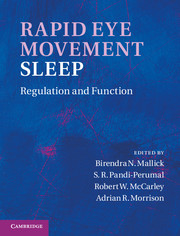Book contents
- Frontmatter
- Contents
- Contributors
- Preface
- Acknowledgments
- Organization
- Section I Historical context
- Section II General biology
- Section III Neuronal regulation
- Section IV Neuroanatomy and neurochemistry
- 19 Aminergic influences in the regulation of basic REM sleep processes
- 20 REM sleep regulation by cholinergic neurons: highlights from 1999 to 2009
- 21 GABAergic modulation of REM sleep
- 22 Glutamatergic regulation of REM sleep
- 23 The role of tuberomammillary nucleus histaminergic neurons, and of their receptors, in the regulation of sleep and waking
- 24 Hypocretinergic system: role in REM-sleep regulation
- 25 Neuropeptides and REM sleep
- 26 Adenosine and glycine in REM-sleep regulation
- 27 Changes in neurotransmitter levels in relation to REM sleep for its regulation
- 28 Pontine areas inhibiting REM sleep
- 29 Neuronal models of REM-sleep control: evolving concepts
- Section V Functional significance
- Section VI Disturbance in the REM sleep-generating mechanism
- Index
- Plate section
- References
22 - Glutamatergic regulation of REM sleep
from Section IV - Neuroanatomy and neurochemistry
Published online by Cambridge University Press: 07 September 2011
- Frontmatter
- Contents
- Contributors
- Preface
- Acknowledgments
- Organization
- Section I Historical context
- Section II General biology
- Section III Neuronal regulation
- Section IV Neuroanatomy and neurochemistry
- 19 Aminergic influences in the regulation of basic REM sleep processes
- 20 REM sleep regulation by cholinergic neurons: highlights from 1999 to 2009
- 21 GABAergic modulation of REM sleep
- 22 Glutamatergic regulation of REM sleep
- 23 The role of tuberomammillary nucleus histaminergic neurons, and of their receptors, in the regulation of sleep and waking
- 24 Hypocretinergic system: role in REM-sleep regulation
- 25 Neuropeptides and REM sleep
- 26 Adenosine and glycine in REM-sleep regulation
- 27 Changes in neurotransmitter levels in relation to REM sleep for its regulation
- 28 Pontine areas inhibiting REM sleep
- 29 Neuronal models of REM-sleep control: evolving concepts
- Section V Functional significance
- Section VI Disturbance in the REM sleep-generating mechanism
- Index
- Plate section
- References
Summary
Summary
Since the discovery of rapid eye movement (REM) sleep (also known as paradoxical sleep, PS), it has been accepted that sleep is an active process. Paradoxical sleep is characterized by electroencephalogram (EEG) rhythmic activity resembling that of waking with a disappearance of muscle tone and the occurrence of REMs in contrast to slow-wave sleep (SWS, also known as non-REM sleep) identified by the presence of delta waves. Here, we review the most recent data indicating that glutamatergic neurons play a key role in the genesis of PS. We propose an updated integrated model of the mechanisms responsible for PS integrating these neurons. We hypothesize that the entrance from SWS to PS is due to the activation of PS-active glutamatergic neurons localized in the pontine sublaterodorsal tegmental nucleus (SLD). We further propose that these neurons are tonically excited across all the sleep–waking cycle by glutamatergic neurons localized in the lateral periaqueductal gray. We finally hypothesize that the onset of activity of the SLD glutamatergic neurons is due to the removal of a GABAergic input from neurons localized in the ventrolateral periaqueductal gray and the adjacent deep mesencephalic reticular nucleus.
- Type
- Chapter
- Information
- Rapid Eye Movement SleepRegulation and Function, pp. 214 - 222Publisher: Cambridge University PressPrint publication year: 2011



